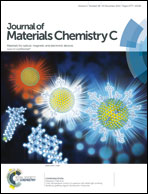CaGdAlO4:Tb3+/Eu3+ as promising phosphors for full-color field emission displays
Abstract
Eu3+ and/or Tb3+-doped CaGdAlO4 phosphor samples were synthesized via a conventional high temperature solid-state reaction process. X-Ray diffraction (XRD), transmission electron microscopy (TEM), photoluminescence (PL) as well as cathodoluminescence (CL) spectra were used to characterize the samples. For CaGdAlO4:Tb3+, the concentration of doped Tb3+ has a significant effect on the 5D3/5D4 emission intensity due to the dipole–dipole cross-relaxation mechanism from 5D3 to 5D4. Under the 4f8 → 4f75d excitation of Tb3+ or low-voltage electron beam excitation, the CaGdAlO4:Tb3+ samples show tunable luminescence from blue to cyan and then to green with the variation of the Tb3+-doping concentration. For CaGdAlO4:Eu3+, the samples exhibit a reddish-orange emission corresponding to the 5D0,1 → 7F0,1,2,3 transitions of Eu3+. Energy transfer can take place from Tb3+ to Eu3+ when they are codoped in one host. Furthermore, for CaGdAlO4:Tb3+/Eu3+, a white emission can be realized in the single phase CaGdAlO4 host by reasonably adjusting the doping concentrations of Tb3+ and Eu3+ under low-voltage electron beam excitation. Due to the excellent PL, CL properties and good CIE chromaticity coordinates, the as-prepared Tb3+/Eu3+-doped CaGdAlO4 nanocrystalline phosphors have potential applications in field emission display devices.


 Please wait while we load your content...
Please wait while we load your content...